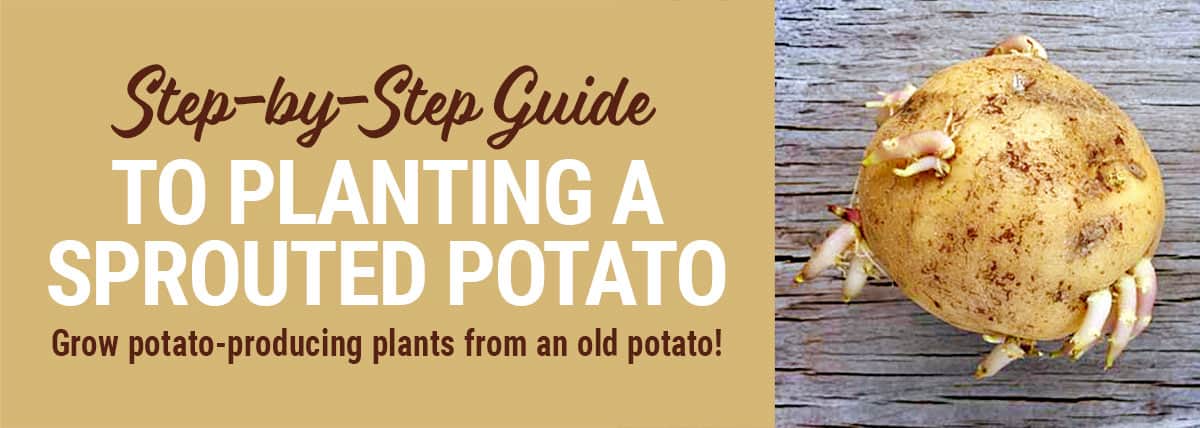
This post may contain affiliate links. As an affiliate, I earn a commission.
Did you discover the potatoes you bought from the grocery store awhile back, and forgot about, have suddenly sprouted in the depths of your pantry?
What should you do? Toss them out? No way! They're still good! You can actually plant those sprouted potatoes to regrow new potatoes and I'm going to tell you how to do it.
Can you just plant sprouted potatoes?
Yes! You can plant a sprouted potato and grow more potatoes.
You will actually get several potato plants and ultimately a bunch of new potatoes from just one sprouted potato if you do it right. It's not difficult, but there are a few tips and tricks to being able to grow a successful potato-producing plant, from an old potato that has sprouted.
★ Steps to Plant a Sprouted Potato ★
You can plant any kind of sprouted potato from sweet potatoes to yellow or white potatoes.
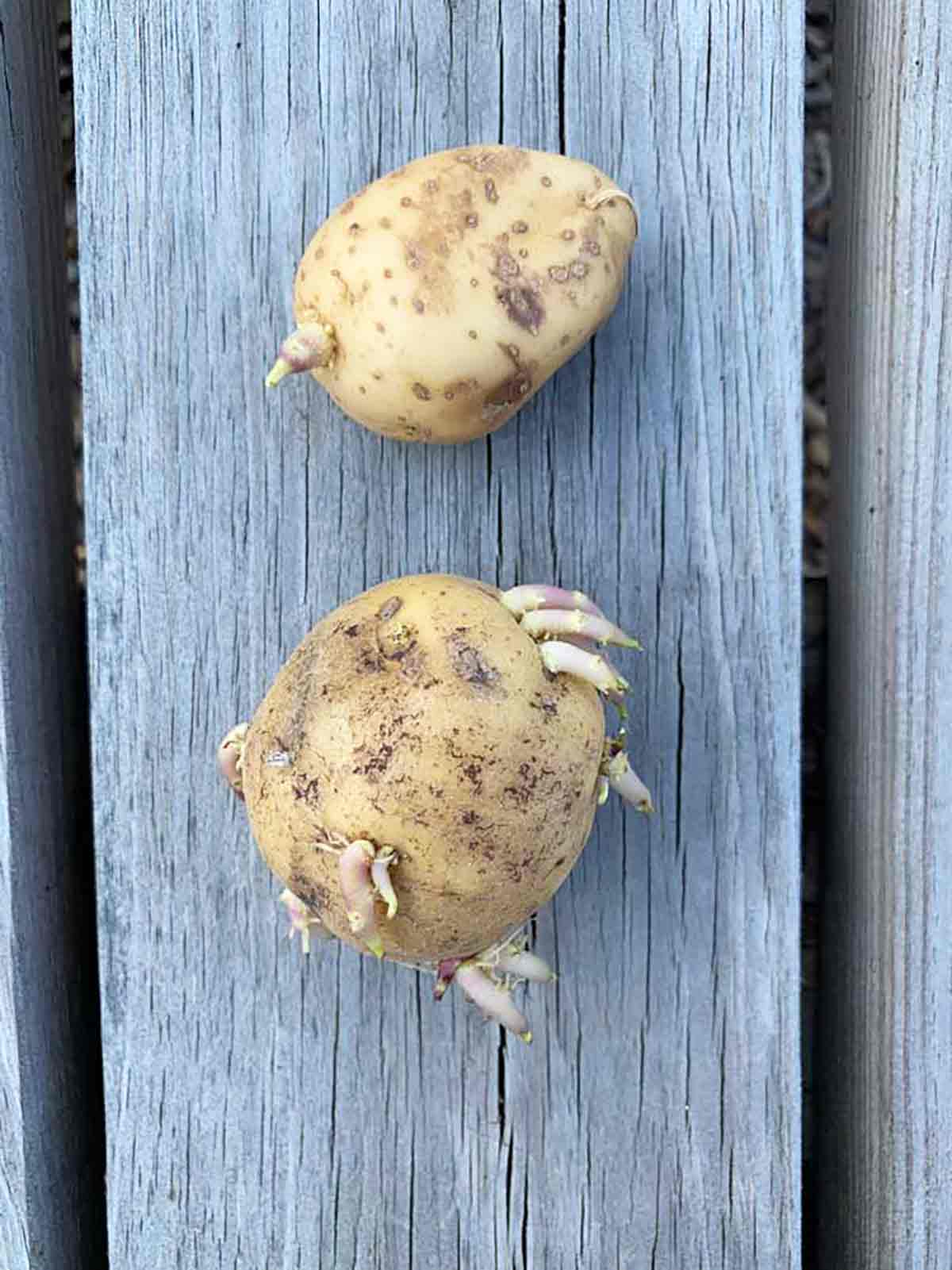
Here's how.
First, don't plant the whole potato in the ground. You'll need to do a little bit of prep to get your sprouted potatoes ready for planting for best results. Don't worry, it's easy. You don't need to be a gardening expert to pull off growing potato plants. Just follow these steps...
Step 1
First, prep your garden bed by mounding soil into rows.
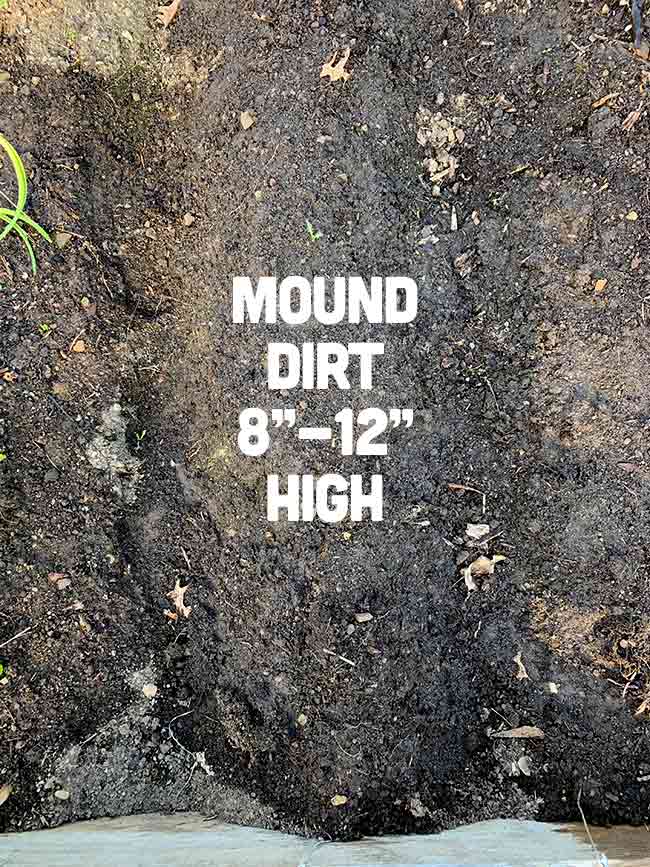
You'll want to plant your potato sprouts within 2-3 days of preparing them so it's best to get your garden bed ready to go, first.
Potato plants grow best when you mound the dirt. This is because potatoes grow underneath the soil. The leaves of the potato plant grow above ground but the roots and potatoes will all develop underground. So the bigger the mound of dirt you create, the more room the potatoes will have to grow.
You can easily mound the soil in your garden by scooping the dirt on either side of the row you create and piling the dirt up in the middle. You want the soil to mound between 8" and 12" tall.
I don't use a special tool for this other than gloves. I just mound the soil with my hands. For larger gardens, you can use a shovel, gardening hoe or rake.
Rows should be about 1 foot apart.
Step 2
Count your potato sprouts.
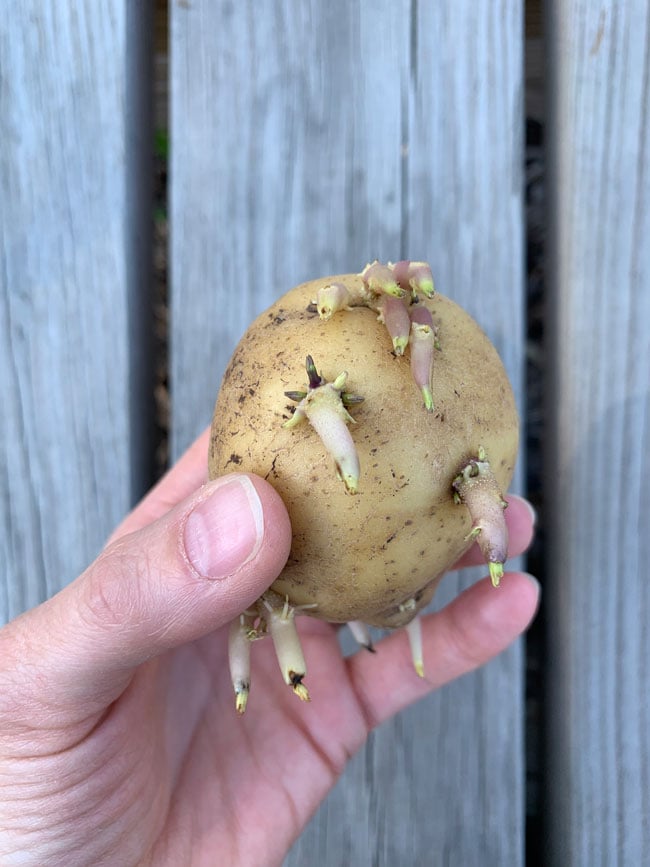
The number of plants you'll be able to get from each potato will depend on how many sprouts the potato has.
A potato sprouts from the eyes on the potato. Each sprouted eye can be cut and grown into a plant. If an eye has multiple sprouts, go ahead and leave those grouped together when you make your cuts.
Each sprouted potato will offer a different number of sprouts.
Step 3
Cut each sprouted eye using a serrated kitchen knife.
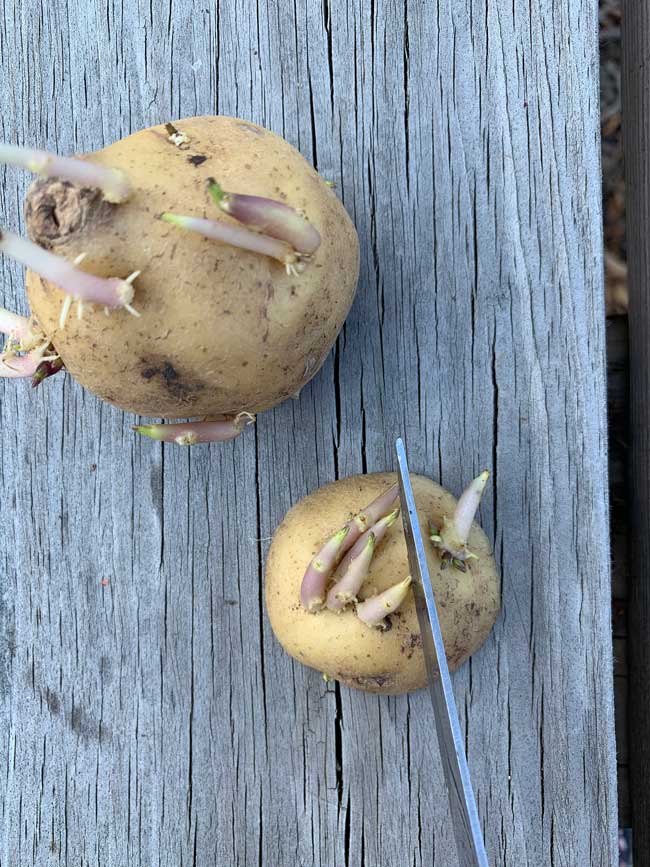
Step 4
Plant your potato sprouts.
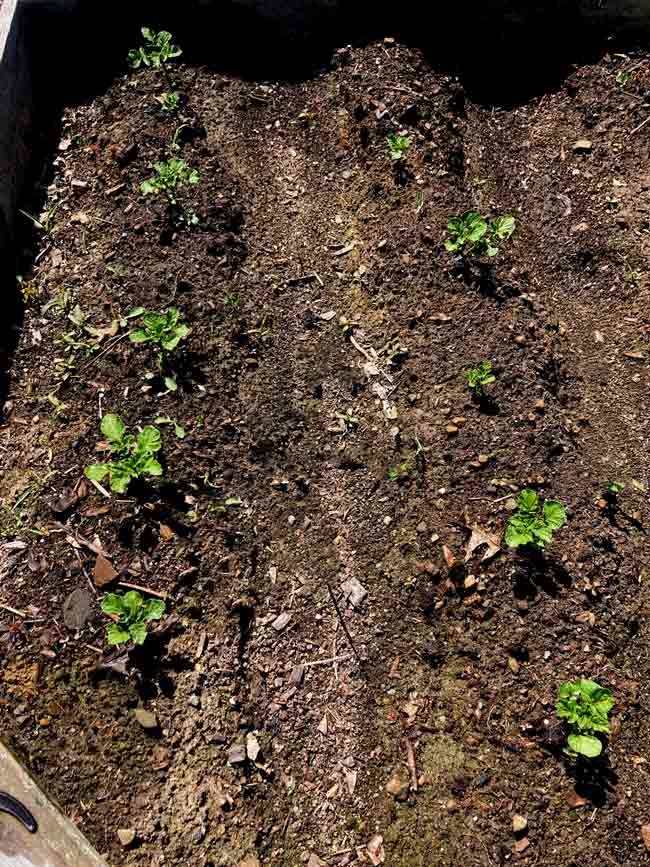
You'll want to plant your potato sprouts within 2-3 days of cutting. Ideally, you will want the skin to dry enough to seal out disease but not too much so that the sprouted parts dry up. You do not need to store the sprouts in water or soak them before planting. Do store them in a cool, dry place after cutting.
Separate the sprouts by cutting away each sprout or group of sprouts, leaving a small amount of potato attached to the sprout.
Potato sprouts should be planted cut-side down, sprout-side facing up. You'll want to plant each sprout 3-4" below the surface of the soil. Plants should be spaced out at least 12" apart so the plants have room to grow both below and above ground.
Planted potato sprouts will take about a weeks to push through the soil and open up their leaves. Keep the plants watered and make sure they get plenty of sun.
What time of year should I plant my potato sprouts?
When you plant, depends on where you live. Generally, early spring is when you will want to plant. You will need to make sure the ground temperature does not drop below 40°F (5°C). Generally the ground is warm enough 2-4 weeks before the last frost of the spring.
Note: Potato plants grow best in soil with a temperature of 45-50°F (8-10˚C). However, can grow in warmer conditions as well.
You can start your potato plants indoors for before transplanting to the ground if the soil temperature is still too cold.
Step 5
Continue to water and weed around your potato plants.
Fertilize your soil if its not very rich. As the plants grow, you can continue to mound soil around the base of the plant.
In general, potatoes need about 3 months to grow and produce a harvest. Some varieties may require more or less time.
Step 6
Harvest your potatoes.
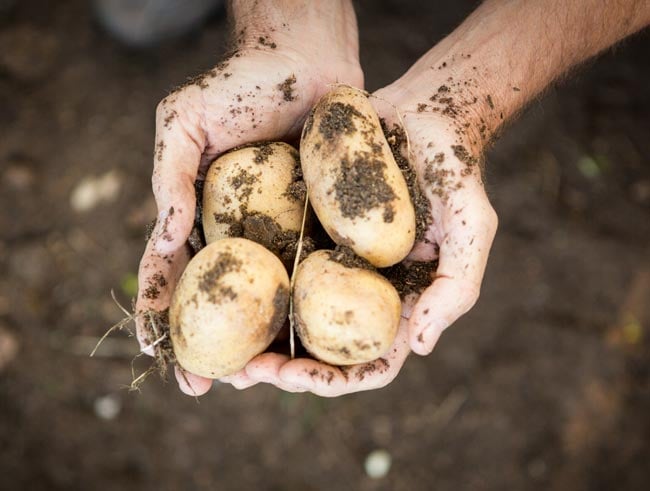
Since the potatoes grow underground, its tricky to tell what you'll get in terms of size or number of potatoes. However, you'll known that your potato plants are ready to be harvested when the visible plant dies off either after the first frost or on its own, usually in the fall.
Then for the fun part! Harvesting potatoes is like digging for treasure. Grab a garden fork and/or some garden gloves if you want to use your hands and dig in! Sift throw the mounded dirt until you find your potatoes. You'll likely get a variety of sizes.
Do not wash your harvested potatoes. You want to keep potatoes dry to avoid rot. To clean off the dirt, use a dry, soft vegetable brush. Store them in a cool dry place. Potatoes can usually be stored for up to 6 weeks or more.
If your potatoes begin to sprout before you get to use them... well, now you know what to do! Use that sprouted potato to grow more potatoes!
★ Tips & FAQs ★
Now let's make some food!
While you're here, check out my easy recipes to get ideas for what to make with your garden-fresh potatoes!

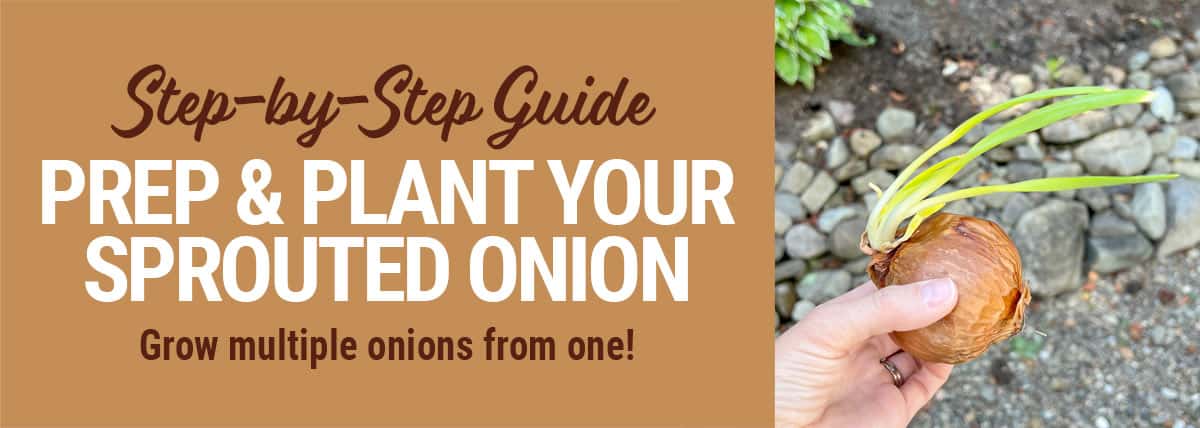

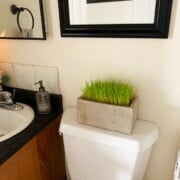


Robin says
Hello my name is Robin, I’m new at gardening Potatoes this season, what are the best companions plants to plant beside the potatoes and what are the worst ones not to plant near them? Thanks in advance
Angela G. says
Hi Robin, Thanks for asking. Potatoes tend to grow well alongside beans, cabbage, and corn. Avoid planting them near tomatoes, peppers, eggplant, and carrots, as these can attract pests and compete for nutrients. Marigolds help improve soil and deter insects — my dad always planted them around his garden. I hope you enjoy your first potato growing season!
Sharla says
Thanks for this very interesting article. I am new to potato growing but it sounds great to me to get more potato plants from fewer seed potatoes.
I have a question: Is this method of planting potato sprouts any quicker or slower than planting chitted whole seed potatoes? Thanks.
Angela G. says
Hi Sharla, I would say this process is very similar to planting chitted potatoes. Chitted potatoes are simply ones that are woken up from their dormant state and have begun sprouting. This is what has already happened when a potato starts sprouting in your pantry. I have planted both store bought potato seeds and cutting of sprouted potatoes and I haven't noticed much of a difference as far as speed in plant growth. The plants get pretty big quickly but then you do have to wait the whole season for the potatoes to grow to a decent size, underground. Hope this helps!
Bettina Wright says
What a great article. Thank you so much! I have a potato that sprouted so I put it in water to see what would happen and now I have a plant sitting in the water with all these white roots sitting in the water. I am not sure if it's too late to plant it, but I'll give it a shot and see what happens. My pup and I love sweet potatoes! 🙂
Brian Cassid says
Question re: Both potatoes and onions. My family used to have an in-ground root cellar below our house and everything stored/over-wintered very well. But, I find that my modern basement just isn't cool enough to store for very long. Can one refrigerate potatoes and onions to prolong their Fall/Winter/Spring 'shelf life'? Thanks in advance!
Angela G. says
Hi Brian, You want to store potatoes you intend to plant but want to remain dormant, at a temp between 35-40˚F. A cool, dark and dry place is important. Your refrigerator would work. When you're ready to let them sprout, move them to a warm place.
Louise says
Just realized I planted my potatoes sprout side down not up. Should I go dig them up and flip them?
Angela G. says
Ideally, yes, you should flip them. Since the sprouts grow upwards, you've giving them a head start by planting them, sprout-side up. Plants are pretty smart, they'll make their way towards sunlight but this will cause some twisting of the stem and could cause the plant to not perform as well.
Gwendolyn says
Hi, I just found some potatoes in my fridge that has buds. I'm going to follow your methods and plant them.. thank you
Jo Reed says
When I was a kid, we had a small farm, and when it was harvest time, the whole family would get out and dig up potatoes. We would store them in a gunny sack filled with sand in our cellar.
Lisa says
It's may 30 ... I'm in Saskatchewan
Is it too late to.plant my sprouted potatoes?
Angela G. says
You will want to go by the ground temperature. 40˚F is ideal. Please see post above for more guidelines on planting temperatures. Thanks for asking!